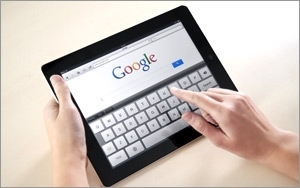What The Mobile Tipping Point In Search Means For Marketers
- by Larissa Faw , January 28, 2015
 The era of cheap mobile clicks is coming to an end. Not that long ago, Google’s Enhanced Campaigns were, in part, designed to level the gap between mobile and desktop
cost-per-clicks (CPC).
The era of cheap mobile clicks is coming to an end. Not that long ago, Google’s Enhanced Campaigns were, in part, designed to level the gap between mobile and desktop
cost-per-clicks (CPC).
But in 2015, search as a whole will cross the “mobile tipping point” with the number of mobile queries exceeding those made via desktops or tablets, according to a study conducted by iProspect, part of Dentsu Aegis Network.
This means paid search in 2015 will be less about purely tactical delivery and more about high-level strategy and brand experience. "If all you’re doing is targeting keywords that align with your consumer and shouting a marketing message at them, you’re losing in search — you need to use strategic audience insights built into a granular, detailed account structure and process to set yourself up to be a good conversation partner in search," says Jeremy Hall, Director of Paid Search, iProspect.
advertisement
advertisement
iProspect's report, based on data from over 1,250 AdWords accounts representing more than 135,000 active campaigns, showcases trends for 2014 as a whole with a special focus on Q4 2014 year-over-year trends.
From 2013 to 2014, paid search impressions decreased while click-through-rates (CTRs) and cost-per-click (CPC) increased. Across all verticals, year-over-year impressions for 2014 vs. 2013 are down (-9%) and clicks are up (+9%), resulting in a CTR increase of 20%.
"The first thing I saw when I dug into the results was the drastic dip in impressions, which really surprised me since I knew we were spending more aggressively—but when I saw that clicks had increased, the impression drop made sense," says Hall.
"In the past year, iProspect has really increased usage of Remarketing Lists for Search Ads (RLSA) in order to focus our spend on the most qualified audiences—and the result was a decrease in lower-value impressions and an increase in quality traffic."
Clients that incorporate mobile into their efforts are increasingly able to see growth, not just from user adoption, but from marketer success, and they’re able to drive tangible, measurable results. To that end, mobile CPCs across iProspect’s performance-based clients increased 67% year-over-year in Q4, driven by this better mobile and cross-device reporting and insights into online-to-offline trends.
The data also allows iProspect to segment trends by vertical. "Different verticals not only have different search audiences and intents, but also different features on the search results pages themselves—by breaking them out, we can not only share overall trends, but trends closely tied to a client’s specific vertical," says Hall.
Retailers, for instance, saw fewer impressions (-14%) and more clicks (+10%) resulting in a 28% higher CTR, while consumer electronics followed a similar pattern, but with more significant swings: impressions down 30%.
Conversely, travel is one of the few verticals that experienced a year-over-year Q4 decrease in clicks (-13%), but it’s worth noting that, for travel, tablet and desktop CPCs are now almost equal having hit a point of convergence that other verticals have yet to reach.
These results illustrate how paid search targeting has shifted from managing bidding to understanding the value of mobile through smarter campaign management and performance measurement. It’s about getting a handle on cross-device conversions and other omni-channel concepts. "Search marketers have more tools than ever before that let us tap into secondary signals beyond the keyword—signals that tell us more about the searcher’s needs in the moment," says Hall. "The more we leverage these tools, the better the results we’ll be able to drive."
Indeed, the increased ability of
advertisers to plug into secondary signals outside of the keyword has allowed digital marketers to focus spend and reduce less qualified impressions.
Specifically, RLSAs and more detailed
targeting allow digital marketers to focus in on key customers at the right moment to drive maximum efficiency, according to the agency. But while personalization based on location and device is
available, many marketers have yet to take full advantage of this functionality in part due to a lack of understanding about it and its potential value.
Meanwhile, Google Product Listing Account (PLA), which accounts for nearly 15% of iProspect’s AdWords spend, experienced massive shifts in 2014. Year-over-year data shows impressions up 130% and clicks up 90%. The corresponding CPC is up 19% overall and +50% for Q4. Over the past several years, this paid ad format has grown signficiantly, and Google has sought to maintain that growth by expanding the types of queries that trigger Google PLAs, per iProspect.
While this strategy succeeds at increasing impressions, in some cases, it trades relevance for scale, reducing performance. Further, this higher volume combined with the increased competition means that Google PLAs no longer provide the easy, almost guaranteed win they once did. There are still, however, strong opportunities. Mobile, for example, saw astronomical Q4 growth in Google PLAs--a 453% increase in impressions and 348% increase in clicks. Overall, 36% of total Q4 Google PLA clicks came from mobile.
Ultimately, search is a conversation and iProspect concludes that the key to utilizing it effectively hinges on the ability to listen to and understand all aspects of each individual’s questions and needs in the moment in order to provide personalized answers—and then manage this personalization at scale. "If you remember that search is an ongoing conversation and look at every new feature, user behavior, and technology through that lens, you’ll succeed in connecting with your audience," says Hall.


